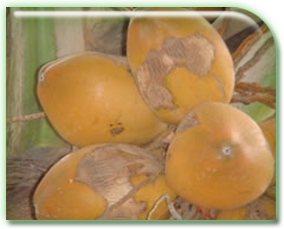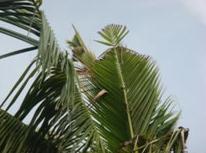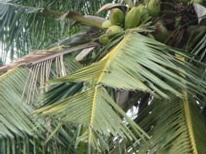| Pests |
Management strategies |
Rhinoceros beetle
Oryctes rhinoceros
|
- Remove and burn all dead coconut trees in the garden (which are likely to serve as breeding ground) to maintain good sanitation.
- Collect and destroy the various bio-stages of the beetle from the manure pits (breeding ground of the pest) whenever manure is lifted from the pits.
- Incorporate the entomopathogen i.e, fungus (Metarrhizium anisopliae) in manure pits to check the perpetuation of the pest.
- Soak castor cake at 1 kg in 5 l of water in small mud pots and keep them in the coconut gardens to attract and kill the adults.
- Treat the longitudinally split tender coconut stem and green petiole of fronds with fresh toddy and keep them in the garden to attract and trap the beetles.
- Examine the crowns of tree at every harvest and hook out and kill the adults.
- For seedlings, apply 3 naphthalene balls/palm weighing 3.5 g each at the base of inter space in leaf sheath in the 3 inner most leaves of the crown once in 45 days.
- Set up light traps following the first rains in summer and monsoon period to attract and kill the adult beetles.
- Field release of Baculovirus inoculated adult rhinoceros beetle @ 15/ha reduces the leaf and crown damage caused by this beetle.
- Apply mixture of either neem seed powder + sand (1:2) @150 g/palm or neem seed kernel powder + sand (1:2) @150 g per palm in the base of the 3 inner most leaves in the crown
- Set up Rhinolure pheromone trap @ 1/ 2 ha to trap and kill the beetles.
|
Black headed caterpillar
Opisina arenosella |
- The incidence of the pest is noticed from the month of November to May and from August to November after rainfall. The coconut trees of all ages are attacked.
- Release the larval (Bethylid, Braconid and Ichneumonid) and pupal (Eulophid) parasitoids and predators periodically from January, to check the build up of the pest during summer.
- Among the larval parasitoids, the bethylid Goniozus nephantidis is the most effective in controlling the pest. The optimum level of release is 1:8 of host-parasitoid ratio. The parasitoid should be released @3000/ha under the coconut trees when the pest is in the 2nd or 3rd instar larval stage. Parasitoids should not be released in the crown region since they will be killed by predators like spiders and reduviid bugs.
- Remove and burn all affected leaves/leaflets.
- Spray Malathion 50 EC 0.05% (1mi/lit) to cover the undersurface of the leaves thoroughly in case of severe epidemic outbreak of the pest in young palms.
|
Red palm weevil
Rhynchophorus ferrugineus
|
- Remove and burn all wilting or damaged palms in coconut gardens to prevent further perpetuation of the pest.
- Avoid injuries on stems of palms as the wounds may serve as oviposition sites for the weevil. Fill all holes in the stem with cement.
- Avoid the cutting of green leaves. If needed, they should be cut about 120 cm away from the stem.
- Setting up of attractant traps (mud pots) containing sugarcane molasses 2½ kg or toddy 2½ litres + acetic acid 5 ml + yeast 5 g + longitudinally split tender coconut stem/logs of green petiole of leaves of 30 numbers in one acre to trap adult red palm weevils in large numbers.
- Root feeding: As under black headed caterpillar
|
Termites
Odontotermes obesus |
- Locate termite mounds in or near the coconut nursery or garden and destroy.
- Swabbing with neem oil 5% once on the base and upto 2 m height of the trunk for effective control.
- Spray Copper sulphate 1 % or Cashew nut shell oil 80 % followed by Copper sulphate 1 % then neem oil 5 % and copper sulphate 1 %, then NSKE 20 % to preserve planted coconut leaves from the termite attack.
|
Scale insect
Aspidiotus destructor |
- Do not harvest nuts for 45 days after spraying.
|
Mealy bugs
Pseudococcus longispinus |
- Remove leaflets harbouring these insects and destroy them
Spray any one of the following :
- Malathion 50 EC 2 ml/lit (or)
- Dimethoate 30 EC 1 ml/lit (or)
- Methyl demeton 25 EC 1 ml/lit (or)
- Phosphamidon 40 SL 1.25 ml/lit (or)
- Methomyl 25 EC 1 ml/lit (or)
- Neem oil 3% (or)
|
Leaf caterpillars
Turnaca acuta |
- Collect and destroy the immature stages of the insects wherever possible and spray Carbaryl 0.1 %.
|
Nut caterpillar |
Nut coreid bug |
Slug caterpillar
Contheyla rotunda |
Spray any one of the following:
- Dichorvos 76 WSC 2 ml/lit
- Bacillus thuringiensis 2 g/lit,
- Triazophos 40 EC 5 ml
- Methyl demeton 25 EC 4 ml/lit
|
Scolytid bark borer beetles
Xyleborus parvulus |
- Stem injection through a stove wick soaked in 0.2% fenthion or 0.2% dichlorvos and plugging the hole and repeating the treatment using the same wick and hole a month after.
|
Palm civet
Vivera zibatha
|
- Poison baiting with ripe banana fruit sandwiched with 0.5 g carbofuran 3 G granules.
|
Rat
Rattus rattus wroughtoni |
- Tree banding with inverted iron cones or Prosophis thorns. Baiting with bromodialone 0.005% at 10 g/tree at crown region twice at an interval of 12 days.
|





